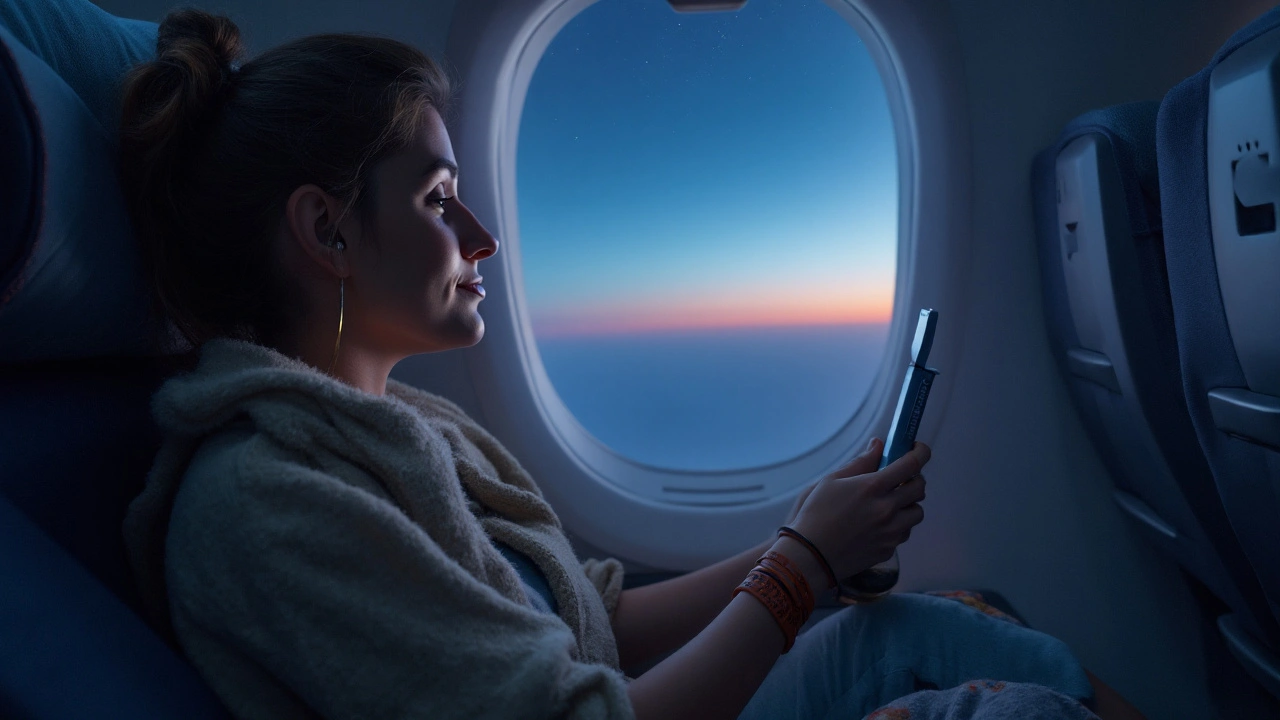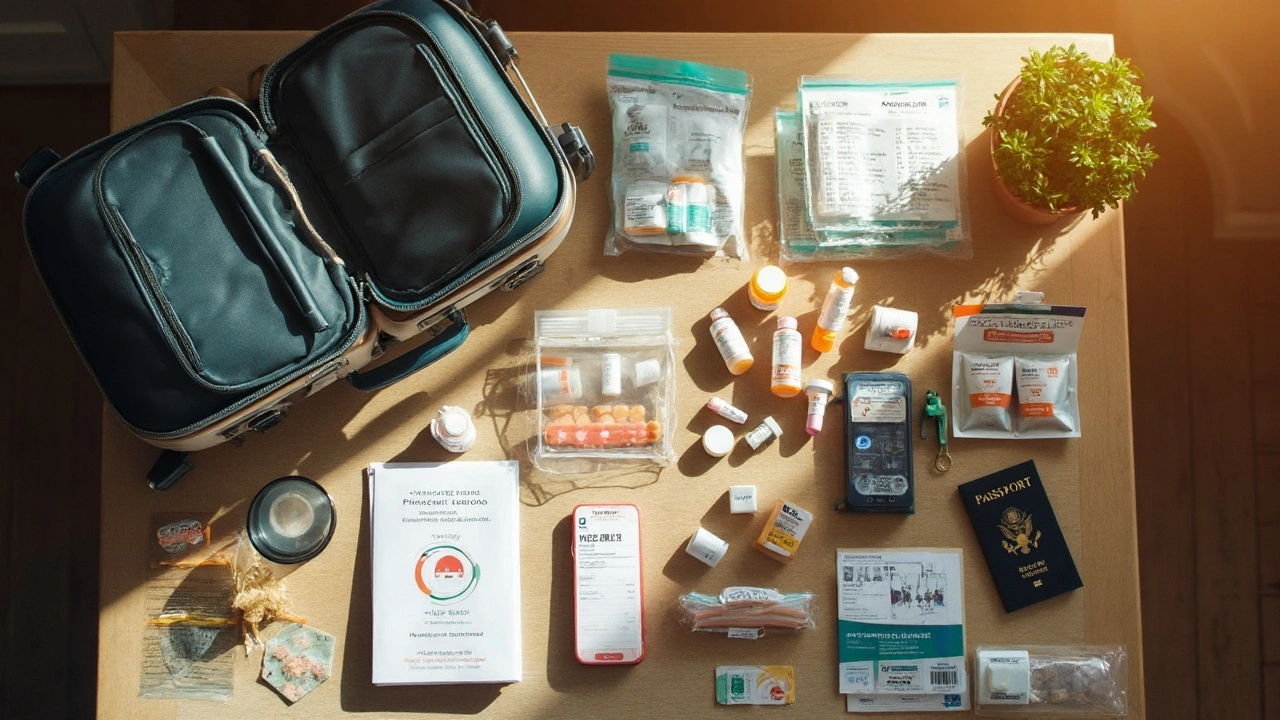You don’t notice good pharmacy prep until something goes wrong-like a migraine at 32,000 feet or a lost inhaler on day one. Here’s the fix: a simple, proven system to pack, carry, and use your medicines anywhere without drama. I’m based in Auckland and travel often; this is the exact playbook I use and refine for 2025, grounded in guidance from WHO, CDC, Medsafe (NZ), and airline/security rules. Expect plain steps, clear checklists, and no false promises-just what works.
TL;DR you can use immediately:
- Pack 2x the meds you need, split 70% carry-on, 30% checked. Keep scripts and names in your phone.
- Put all essential meds in carry-on. Liquid meds can exceed 100 ml if “medically necessary,” but you must declare them at security.
- Travel letter + original packaging lowers hassles with syringes/inhalers/controlled drugs.
- Heat kills meds faster than cold. Use an insulated pouch or a Frio-style case for insulin and biologics.
- Do a quick vaccine/health check 4-6 weeks before departure (hepatitis A, typhoid, etc., based on your route).
Here are the key jobs you’re trying to do after clicking this: avoid running out of meds, pass airport security smoothly, prevent common travel illnesses, keep meds safe from heat/time zones, and know what to do when plans blow up. That’s what this guide covers-start to finish. If you remember one line, make it this: pharmacy tips for travelers only work if you prep early and keep essentials on your body, not in the hold.
Fast answers: TL;DR, must-pack meds, and the rules that actually matter
Let’s keep this tight. Below are the non-negotiables and how they map to real rules from aviation/security authorities and health agencies. This section answers, “What do I pack, and how do I get it through?”
What to pack (essentials you’ll actually use):
- Your daily prescriptions (2x the trip length). If you take three meds daily, build two kits: one for carry-on, one backup in checked luggage.
- Fast-action pain relief: paracetamol and/or ibuprofen.
- Anti-diarrhoeals (loperamide), oral rehydration salts, and a simple probiotic if you tolerate them.
- Antihistamine (cetirizine or loratadine) + a steroid nasal spray if you get hayfever.
- Motion sickness treatment: meclizine or scopolamine patch (if prescribed), plus ginger chews as a mild backup.
- A broad antiseptic (povidone-iodine swabs) and a few hydrocolloid plasters for blisters/cuts.
- Jet lag helpers: melatonin (where legal) or a sleep routine plan; caffeine if that’s your style.
- Destination add-ons: altitude meds (acetazolamide, if prescribed), malaria prophylaxis (if indicated), DEET-based repellent, sunscreen SPF 50+, a small thermometer. In tropics, consider permethrin-treated clothing and a plug-in mosquito repeller.
Airport security in simple terms (2025 reality):
- Solid medications: Usually unlimited in carry-on in the US (TSA), EU/UK, Australia, and NZ. Keep them accessible for inspection.
- Liquid medications: “Medically necessary” liquids can exceed 100 ml/3.4 oz. Declare them at security and be ready to show documentation. Expect extra screening.
- Injection devices (insulin pens, EpiPens, syringes): Allowed when accompanied by prescription labels or a doctor’s letter. Keep in original packaging if possible.
- Controlled medicines (e.g., certain ADHD meds, opioids, some anxiety meds): Rules vary by country. Carry prescriptions and a travel letter. For some destinations, check embassy guidance in advance or get an import permit (common with stimulant medications).
- Names matter: Keep your name on labels matching your passport. If you re-bottle, carry a photo of the original label and a digital copy of the script.
Heat, light, and time zone basics:
- Heat is the enemy. Don’t put meds in checked luggage if you can avoid it-it can sit on tarmac in 35-40°C sun. Insulate insulin/biologics with a cooling sleeve; never freeze them.
- Light degrades some meds (e.g., nitroglycerin). Keep in original amber bottles when possible.
- Time zones: For once-daily meds, aim for roughly the same spacing (24±3 hours). For critical meds (e.g., anti-seizure), ask your GP/pharmacist for a stepwise shift plan or set alarms to prevent missed doses during long-hauls.
Authority sources I lean on when I plan:
- WHO and CDC: destination health risks, vaccines, and outbreaks.
- Medsafe (NZ) and your country’s medicines regulator: legal status of meds and safety alerts.
- Airline and airport security sites (TSA for US flights, EU/UK security guidance, Australian and NZ aviation security): what you can bring and how to declare it.
- IATA: high-level guidance for medical devices and batteries (CPAP, portable fridges).
Quick legal sanity check:
- If your medicine is a controlled substance at home or abroad, read embassy guidance 2-4 weeks in advance.
- Always carry the generic (international nonproprietary) name in case brands differ overseas.
- Keep a doctor’s letter if you travel with needles, liquid meds over 100 ml, or controlled meds. One page is enough: diagnosis, medication names/doses, devices, and your full name and DOB.
| Region/Authority | Solids in Carry-On | Liquid Meds | Documentation | Declare at Security? |
|---|---|---|---|---|
| USA (TSA) | Allowed, no fixed limit | Allowed in “reasonable quantities” beyond 3.4 oz if medically necessary | Prescription label recommended; letter helpful | Yes-separate and declare liquids |
| EU/UK airport security | Allowed | Exempt from 100 ml if medically necessary; screening likely | Proof recommended (script/letter) | Yes-present separately |
| Australia (Home Affairs/TravelSecure) | Allowed | Medical liquids permitted; subject to screening | Prescription/letter recommended; original packaging | Yes |
| New Zealand (Aviation Security) | Allowed | Medical liquids permitted; screen separately | Prescription/letter recommended | Yes |
| General (IATA guidance) | Airline policies may add conditions | Permitted as medically necessary; check airline for devices | Carry a doctor’s letter for injectables/controlled meds | Varies-declare when in doubt |

The step-by-step playbook: plan, pack, fly, arrive
Here’s the clean, repeatable process I use for every trip. If you follow these steps, you’ll handle 95% of medication issues before they ever happen.
4-6 weeks before you go
- Map your risks: destination (tropical? altitude? rural?), activities (diving? hiking?), and personal factors (pregnancy, chronic disease, immunocompromise).
- Check vaccines: hepatitis A, typhoid, routine boosters (tetanus, MMR), and region-specific ones (e.g., Japanese encephalitis) based on WHO/CDC and local travel clinics. If you’re short on time, ask what can be fast-tracked.
- Review scripts: Ask your GP or pharmacist for a full list with generic names, plus repeats to cover 2x travel length. If you’re on controlled meds, ask about destination rules and whether a permit is needed.
- Insurance: Confirm cover for existing conditions and replacement meds abroad. Add a telehealth option if your plan has it.
- Devices: If you use CPAP, insulin pumps, or portable fridges, email the airline now for battery/device approval. Screenshot the confirmation.
7-10 days before
- Build your kits: Main kit in carry-on, slim backup in checked. Use small organizers or zip bags labelled by use (pain, stomach, allergy, sleep, wounds).
- Print a one-page med summary: name, DOB, conditions, meds with generic names/doses, allergies, emergency contacts. Save PDFs on your phone and a cloud folder.
- Temperature plan: Get an insulated pouch and cold packs (if needed). Test-fit in your day pack.
- Refill prescriptions: Check expiry dates and amounts. For blister packs, keep a few in original packaging with the pharmacy label visible.
- Custom add-ons: Malaria prophylaxis, altitude meds, or travellers’ diarrhoea standby antibiotics if your clinician agrees (especially for remote travel).
Airport day
- Keep meds in your personal item, not the overhead bin if the flight is full. If gate agents ask you to check your roller bag, your meds stay with you.
- Security: Pull out liquid meds and devices; declare calmly. Short and clear works: “These are medically necessary liquids and insulin pens. I have scripts.”
- On the plane: Take scheduled meds with snacks and water. Set alarms for long-hauls to avoid missed doses. If you get motion sick, medicate 30-60 minutes before pushback.
On arrival
- Customs: Some countries ask about meds on arrival cards. Declare if requested; present your letter and scripts. Simple honesty saves time.
- Storage: Hotel safes can get warm. Use a cool, dark drawer. For biologics/insulin, ask housekeeping for a mini-fridge temp check (2-8°C is the sweet spot).
- Refills abroad: Use brand-generic cross-checking. Show your script and ask the pharmacist to match the active ingredient and dose. If language is a barrier, write it down or use a translation app.
Practical examples
- City break in Tokyo, 5 days: Daily antihypertensive + occasional migraine tablets. Action: Put all dailies in a labelled travel bottle, keep 5 extra days in your backup kit. Carry your migraine med in a side pocket you can grab during boarding.
- Southeast Asia, 3 weeks: Food-borne illness risk + mosquitoes. Action: Pack loperamide, ORS, a course of azithromycin if your clinician approves, DEET 30-50%, and sunscreen. Check hepatitis A/typhoid status. Consider probiotics starting two days pre-flight.
- Peru trek, altitude: Discuss acetazolamide 125-250 mg with your clinician, start 24 hours before ascent. Add blister plasters, strong sunscreen, and a lightweight compression bandage.
Heuristics and rules of thumb
- The 2x Rule: Bring twice what you need. Travel delays are normal now.
- The 70/30 Split: 70% of meds in carry-on, 30% backup in checked luggage.
- The “Declare If Unsure” Rule: If it looks like a medical liquid or device, declare it.
- The Generic Backup: Always know the generic names. Brands change; molecules don’t.
- Heat First, Cold Second: Protect from heat above all. Cold is only a problem if freezing.
Pitfalls to avoid
- Decanting everything into unlabeled baggies. Keep at least a portion in original packaging with your name.
- Checking all your meds. Bags go missing.
- Starting new meds right before travel without a test dose at home. You want to spot side effects early.
- Using alcohol to “help sleep” when using sedatives, antihistamines, or opioids. Interaction risk is real.

Quick tools: checklists, cheat-sheets, FAQ, troubleshooting
Use this section when you’re packing at midnight or fixing problems on the road.
Carry-on med kit checklist
- Daily prescriptions (2x quantity), labels visible on at least one package
- Doctor’s letter (simple, one page) and digital copies of scripts
- Pain relief (paracetamol/ibuprofen), antihistamine, loperamide, ORS
- Motion sickness med, melatonin (if legal), eye drops (preservative-free vials)
- Antiseptic swabs, hydrocolloid plasters, small bandage, tweezers
- Inhaler/EpiPen/insulin pens with spare needles; cooling pouch if needed
- DEET-based repellent, SPF 50+ sunscreen (travel size unless medically necessary)
- Thermometer, lip balm, saline nasal spray (dry cabin air fix)
- USB battery for medical devices (check airline watt-hour limits)
Checked bag backup (slim set)
- Duplicate of critical meds (30% of total)
- Spare ORS packets, extra plasters, small tube of antiseptic
- Spare cooling gel pack (room temp type)
Time-zone dosing cheat-sheet
- Once-daily meds: Shift by 1-2 hours per day before travel, or take at destination bedtime if within ±3 hours of your usual schedule.
- Twice-daily meds: Keep roughly 12-hour spacing; set alarms for flight day. If you miss by >4 hours, call your pharmacist for catch-up advice.
- Critical window meds (anti-seizure, transplant, insulin regimens): Get a written plan from your clinician for dose timing across flights.
When things go sideways (troubleshooting)
- You lose a prescription med: Go to a reputable pharmacy. Show your script/photo and your ID. If the drug is controlled, you may need a local prescriber-ask the pharmacy who can see you same day. Use your travel insurance telehealth if available.
- Your insulin got too warm: Check the product’s stability guide. Most insulin tolerates room temp for a set number of days but not >30°C for long periods. If it looks cloudy or has clumps (when it shouldn’t), replace it.
- Brutal traveller’s diarrhoea: Rehydrate first (ORS). Loperamide helps symptoms; add your standby antibiotic only if your clinician advised it and your symptoms fit (fever/bloody stools = seek care, no self-medication).
- Altitude headache day one: Rest, hydrate, avoid alcohol, consider acetaminophen. If you have acetazolamide per plan, start/continue. Worsening symptoms can signal AMS-descend and seek medical help.
- Jet lag crushing you: Morning light at destination, melatonin low dose (0.5-3 mg) 2-3 hours before target bedtime if legal where you are, and short naps (<30 min).
Mini-FAQ
- Can I bring liquid meds over 100 ml? Yes if medically necessary. Declare them at security. Keep a script or letter handy.
- Do meds need original packaging? Not legally everywhere, but it helps. Keep at least part of your supply in original labelled packs.
- What about needles and syringes? Allowed when medically necessary. Carry a letter and keep them with your meds, not loose.
- Are my NZ prescriptions valid overseas? Not as-is for dispensing, mostly. You can use them to inform a local prescriber/pharmacist. Some medicines can be sold over-the-counter abroad in different strengths-always verify the active ingredient and dose.
- How do I store meds in hostels? Use a small lockbox in your bag for pills; for fridge items, ask staff to place them in a labelled container in the staff fridge and note the temperature.
Scenarios and smart trade-offs
- Carry a big first-aid kit or buy locally? Pack basics you’ll need in the first 24-48 hours. After that, local pharmacies can handle the rest.
- Melatonin legal status varies. If you’re unsure, buy at your destination or use a sleep timing plan without supplements.
- Standby antibiotics: Useful for remote trips or high-risk travel, but not for everyone. Overuse drives resistance; get tailored advice.
Credibility notes
- WHO and CDC provide current vaccine and travel health risk maps.
- Medsafe (NZ) keeps updated medicine advisories and legal status.
- TSA, EU/UK, Australian, and NZ aviation authorities publish medication carriage rules and screening procedures.
- IATA outlines battery/device carriage rules (helpful for CPAP and portable coolers).
Next steps if you want this done in one hour
- Download/print your med list and scripts to your phone/cloud.
- Lay out your kits on a table: daily meds, symptom relief, destination add-ons, wound care, devices.
- Pack carry-on first, then assemble your checked backup.
- Write a one-page doctor’s letter (or ask your clinic) covering meds/devices.
- Set phone reminders for dose times through travel day and first 72 hours abroad.
A quick word from Auckland
I plan my med kits the same way I plan a surf session on the West Coast-assume the weather changes, and pack for it. When flights get reshuffled and bags go missing, the people who keep their essentials on them and know their generic names ship through problems. That can be you on your next trip. Safe travels.


